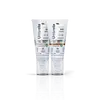What's inside
What's inside
 Key Ingredients
Key Ingredients

 Benefits
Benefits

 Concerns
Concerns

 Ingredients Side-by-side
Ingredients Side-by-side

Isodecyl Neopentanoate
EmollientCaprylyl Methicone
Skin ConditioningCyclopentasiloxane
EmollientMethylene Bis-Benzotriazolyl Tetramethylbutylphenol
UV FilterEthylhexyl Methoxycinnamate
UV AbsorberLauryl PEG-10 Tris(Trimethylsiloxy)Silylethyl Dimethicone
EmulsifyingDiethylamino Hydroxybenzoyl Hexyl Benzoate
UV FilterPropylheptyl Caprylate
EmollientTitanium Dioxide
Cosmetic ColorantPhenyl Trimethicone
Skin ConditioningIsostearyl Isostearate
EmollientZinc Oxide
Cosmetic ColorantIsododecane
EmollientDimethicone
EmollientTalc
AbrasiveDibutyl Adipate
EmollientTribehenin
EmollientBis-Ethylhexyl Hydroxydimethoxy Benzylmalonate
AntioxidantSodium Potassium Aluminum Silicate
Caprylyl Glycol
EmollientCitric Acid
Buffering1,2-Hexanediol
Skin ConditioningKaolin
AbrasiveIsodecyl Neopentanoate, Caprylyl Methicone, Cyclopentasiloxane, Methylene Bis-Benzotriazolyl Tetramethylbutylphenol, Ethylhexyl Methoxycinnamate, Lauryl PEG-10 Tris(Trimethylsiloxy)Silylethyl Dimethicone, Diethylamino Hydroxybenzoyl Hexyl Benzoate, Propylheptyl Caprylate, Titanium Dioxide, Phenyl Trimethicone, Isostearyl Isostearate, Zinc Oxide, Isododecane, Dimethicone, Talc, Dibutyl Adipate, Tribehenin, Bis-Ethylhexyl Hydroxydimethoxy Benzylmalonate, Sodium Potassium Aluminum Silicate, Caprylyl Glycol, Citric Acid, 1,2-Hexanediol, Kaolin
Water
Skin ConditioningTitanium Dioxide
Cosmetic ColorantC12-15 Alkyl Benzoate
AntimicrobialSilica
AbrasiveEthylhexyl Salicylate
UV AbsorberButyl Methoxydibenzoylmethane
UV AbsorberBis-Ethylhexyloxyphenol Methoxyphenyl Triazine
Skin ConditioningDimethicone
EmollientEthylhexyl Triazone
UV AbsorberGlycerin
HumectantOctocrylene
UV AbsorberPentylene Glycol
Skin ConditioningAluminum Starch Octenylsuccinate
AbsorbentTriethanolamine
BufferingStearic Acid
CleansingPotassium Cetyl Phosphate
EmulsifyingMethyl Methacrylate Crosspolymer
Methylene Bis-Benzotriazolyl Tetramethylbutylphenol
UV FilterNylon-12
Propylene Glycol
HumectantSynthetic Wax
AbrasiveTerephthalylidene Dicamphor Sulfonic Acid
UV AbsorberPalmitic Acid
EmollientPEG-100 Stearate
Glyceryl Stearate
EmollientPhenoxyethanol
PreservativeSilica Silylate
EmollientDrometrizole Trisiloxane
UV AbsorberAmmonium Polyacryloyldimethyl Taurate
Emulsion StabilisingIsopropyl Lauroyl Sarcosinate
Skin ConditioningPoloxamer 338
EmulsifyingAluminum Hydroxide
EmollientStearyl Alcohol
EmollientTocopherol
AntioxidantCaprylyl Glycol
EmollientPolyglyceryl-10 Laurate
Skin ConditioningButylene Glycol
HumectantDisodium EDTA
Hydroxypropyl Methylcellulose
Emulsion StabilisingMyristic Acid
CleansingSodium Chloride
MaskingBenzyl Benzoate
AntimicrobialBenzyl Alcohol
PerfumingParfum
MaskingWater, Titanium Dioxide, C12-15 Alkyl Benzoate, Silica, Ethylhexyl Salicylate, Butyl Methoxydibenzoylmethane, Bis-Ethylhexyloxyphenol Methoxyphenyl Triazine, Dimethicone, Ethylhexyl Triazone, Glycerin, Octocrylene, Pentylene Glycol, Aluminum Starch Octenylsuccinate, Triethanolamine, Stearic Acid, Potassium Cetyl Phosphate, Methyl Methacrylate Crosspolymer, Methylene Bis-Benzotriazolyl Tetramethylbutylphenol, Nylon-12, Propylene Glycol, Synthetic Wax, Terephthalylidene Dicamphor Sulfonic Acid, Palmitic Acid, PEG-100 Stearate, Glyceryl Stearate, Phenoxyethanol, Silica Silylate, Drometrizole Trisiloxane, Ammonium Polyacryloyldimethyl Taurate, Isopropyl Lauroyl Sarcosinate, Poloxamer 338, Aluminum Hydroxide, Stearyl Alcohol, Tocopherol, Caprylyl Glycol, Polyglyceryl-10 Laurate, Butylene Glycol, Disodium EDTA, Hydroxypropyl Methylcellulose, Myristic Acid, Sodium Chloride, Benzyl Benzoate, Benzyl Alcohol, Parfum
Ingredients Explained
These ingredients are found in both products.
Ingredients higher up in an ingredient list are typically present in a larger amount.
Caprylyl Glycol is a humectant and emollient, meaning it attracts and preserves moisture.
It is a common ingredient in many products, especially those designed to hydrate skin. The primary benefits are retaining moisture, skin softening, and promoting a healthy skin barrier.
Though Caprylyl Glycol is an alcohol derived from fatty acids, it is not the kind that can dry out skin.
This ingredient is also used as a preservative to extend the life of products. It has slight antimicrobial properties.
Learn more about Caprylyl GlycolDimethicone is a type of synthetic silicone created from natural materials such as quartz.
What it does:
Dimethicone comes in different viscosities:
Depending on the viscosity, dimethicone has different properties.
Ingredients lists don't always show which type is used, so we recommend reaching out to the brand if you have questions about the viscosity.
This ingredient is unlikely to cause irritation because it does not get absorbed into skin. However, people with silicone allergies should be careful about using this ingredient.
Note: Dimethicone may contribute to pilling. This is because it is not oil or water soluble, so pilling may occur when layered with products. When mixed with heavy oils in a formula, the outcome is also quite greasy.
Learn more about DimethiconeMethylene Bis-Benzotriazolyl Tetramethylbutylphenol (Tinosorb M) is a hybrid and broad-spectrum UV ingredient. It is both a UV absorber and filter.
UV absorbers are an agent that absorbs UV rays. They protect your skin by using chemical reactions to convert UV rays into heat and energy. UV filters physically reduce the amount of UV rays from reaching your skin.
Tinosorb M covers a range of 280-400 nm and is photostable. This ingredient is neither oil or water soluble.
Tinosorb M is not available in the US. However, it is available in the EU and Asia.
It's sister, Tinosorb S, is set to be approved in the US by late 2025 (fingers crossed!).
Learn more about Methylene Bis-Benzotriazolyl TetramethylbutylphenolTitanium dioxide is a mineral UV filter widely used in sunscreens and cosmetics.
It is one of only two UV filters officially classified as “mineral” by regulatory agencies, the other being zinc oxide.
Titanium dioxide provides broad-spectrum protection mostly in the UVB and UVAII range, with some protection in the UVAI range.
While its UVA protection isn’t as strong as zinc oxide’s, the difference is minor.
A common myth is that mineral UV filters reflect UV light. However, modern research shows titanium dioxide absorbs UV radiation like chemical filters (~95% absorption & 5% reflection).
Thanks to its non-irritating nature, titanium dioxide is suitable for sensitive, acne-prone, or redness-prone skin. It is unlikely to cause "eye sting" like other sunscreen ingredients.
A major drawback of this ingredient is its white cast and thick texture. This is why mineral sunscreens often leave a white cast and are less cosmetically elegant than chemical/hybrid sunscreens.
To improve white cast and spreadability, micronized or nano-sized titanium dioxide is often used.
There are ongoing concerns surrounding nano-titanium oxide's impact on marine ecosystems.
There is no conclusive evidence that any form of titanium oxide (or any other sunscreen ingredients) will cause harm to marine ecosystems or coral reefs. The science is still developing but many consumers are keeping a close eye on this issue.
Please note, many destinations have reef-safety sunscreen rules. For instance, the U.S. Virgin Islands advises all visitors to use non-nano mineral sunscreens.
Nano mineral sunscreens once raised safety concerns about absorption into skin.
Extensive research has shown that they do not penetrate healthy or damaged skin; they remain safely on the surface and the top layer of dead skin (stratum corneum).
You'll likely find titanium dioxide bundled with alumina, silica, or dimethicone. These ingredients help make titanium dioxide highly photostable; this prevents it from interacting with other formula components under UV light.
Learn more about Titanium Dioxide